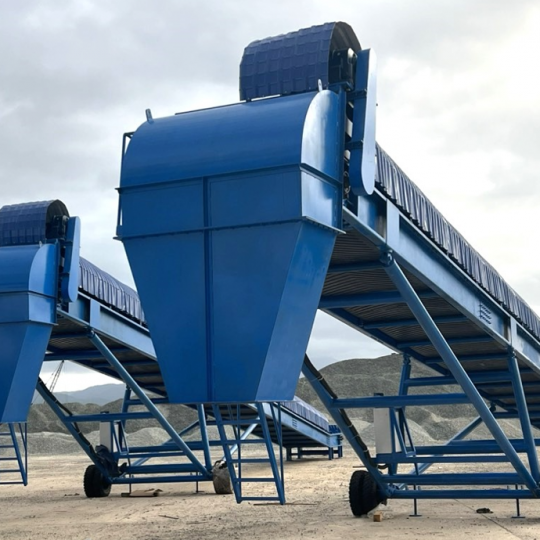- Email: st@cokhisontung.com.vn
- Hotline: 0913 602 660
- Website: gaungoam.vn
Băng Tải Trung Gian 27x1.4 Mét
Băng tải cầu cảng là một trong những thiết bị vô cùng quan trọng trong ngành vận chuyển nói chung và bốc xếp hàng hóa nói riêng. Băng tải có nhiệm vụ vận chuyển hàng hóa đến các bến cảng để nhập khẩu, xuất khẩu một cách nhanh chóng và hiệu quả. Ngoài ra, những loại băng tải có công suất lớn còn được sử dụng để vận chuyển các vật liệu có tải trọng lớn dễ dàng hơn. Cùng Gầu Ngoạm Sơn Tùng tìm hiểu chi tiết về loại băng tải này cũng như một số ứng dụng của nó nhé!
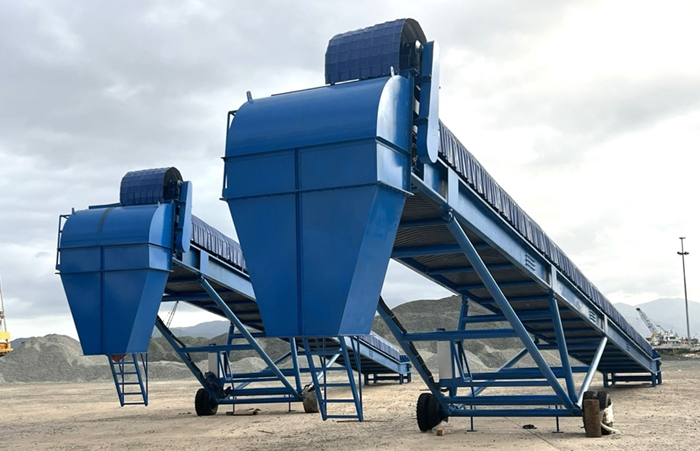
Cơ khí Sơn Tùng - Địa chỉ cung cấp băng tải cầu cảng uy tín
Thế nào là băng tải cầu cảng?
Băng tải cầu cảng là thiết bị dùng để vận chuyển hàng hóa từ đường thủy lên đường bộ (xà lan, ghe tàu). Băng tải cầu cảng được sử dụng ở kho bãi hoặc các cảng với 02 loại chính là băng tải di động và băng tải cố định. Tùy thuộc vào địa hình cũng như loại hàng hóa cần vận chuyển để lựa chọn loại băng tải phù hợp.
Ngoài ra, đơn vị có thể kết hợp linh hoạt 02 loại băng tải này để tạo nên một hệ thống truyền tải tối ưu nhất. Mặc dù có 02 loại băng tải nhưng cả 02 loại trên đều có sự tương đồng về chất liệu. Hầu hết các bộ phận như tang chủ động, tang bị động, khung sườn, con lăn đỡ dây dưới,... đều được làm từ thép không gỉ. Chính vì vậy, băng tải có thể đảm nhận tốt công việc và có độ bên khá cao trong mọi điều kiện thời tiết. Thực tế, để hạn chế những va đập không đáng có, thiết bị có thể được trang bị thêm các động cơ giảm tốc để hàng hóa vận chuyển nhịp nhàng hơn.
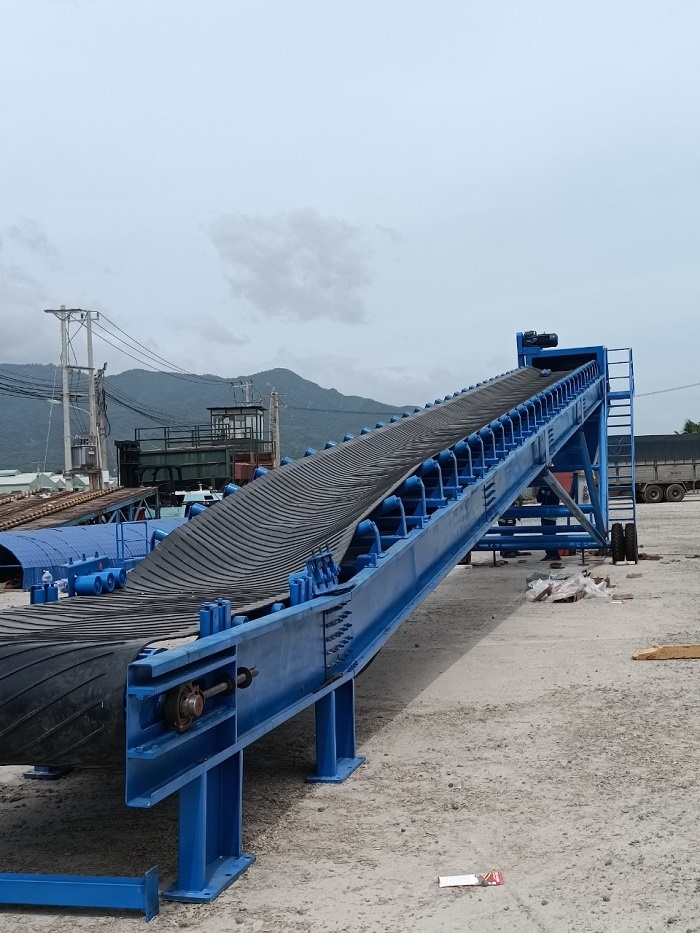
Tìm hiểu về băng tải cầu cảng
Cấu tạo cơ bản của băng tải cầu cảng
Băng tải cầu cảng được cấu tạo bởi các bộ phận cơ bản, bao gồm: Băng tải, dây băng tải, tang trống, con lăn,…
Băng tải
Băng tải gồm băng tải – một khung trụ, đảm bảo cố định kết cấu hệ thống nâng hạ. Ngoài ra, băng tải còn có một số bộ phận khác như dẫn động, con lăn đỡ dây, thiết bị căng dây, chi tiết làm sạch băng tải cùng một số thiết bị khác.
Dây băng tải
Dây băng tải: Gồm có 02 loại dây chính là đai nhựa và dây băng tải cao su.
- Dây cao su thích hợp với môi trường làm việc có nhiệt độ từ -15 đến 45 độ C và được sử dụng để vận chuyển các loại vật liệu có độ nghiêng nhỏ.
- Đai nhựa: Có khả năng kháng acid, kháng kiềm, kháng dầu,…với độ rộng bằng độ rộng của băng tải.
Con lăn
Con lăn băng tải gồm có 02 loại là con lăn đôi và con lăn đơn, ngoài ra còn có bộ làm biến phẳng, bộ làm biếng đệm bộ làm biến dạng máng và bộ làm biến tự sắp xếp. Các bộ làm biến hỗ trợ chịu lực và dùng trong vận chuyển vật liệu rời. Các bộ không tải điều chỉnh vị trí ngang của phần dây đai trong khi bộ miếng đệm sẽ hỗ trợ làm giảm tác động của phần vật liệu lên dây đai.
Tang trống
Băng tải có 02 tang trống chính: Tang trống đảo chiều và tang dẫn động. Tang trống có nhiều con lăn đôi, con lăn đơn đảm nhận nhiệm vụ chính là truyền lực.
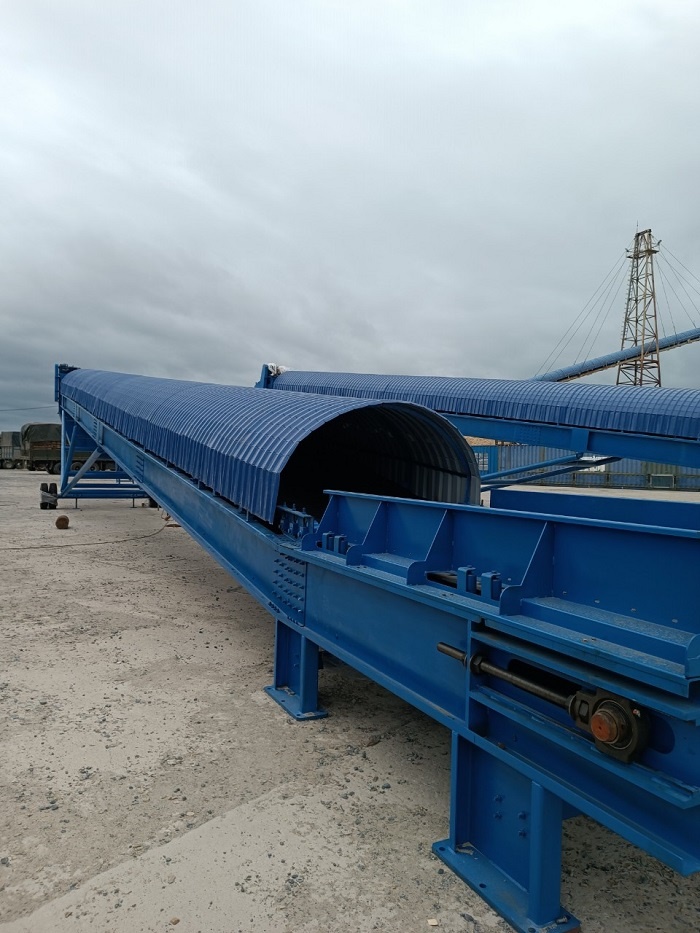
Cấu tạo cơ bản của băng tải cầu cảng
Phân loại và yêu cầu về băng tải cầu cảng
Hiện nay, băng tải cầu cảng có nhiều loại với nhiều công năng khác nhau và mức giá cũng có phần chênh lệch. Dưới đây là một số loại thông dụng và được sử dụng khá phổ biến:
- Băng tải cầu cảng kiểu truyền thống.
- Băng tải cầu cảng 02 trụ cáp treo.
- Băng tải cầu cảng 04 trụ cáp treo.
- Băng tải cầu cảng 04 cánh.
Phân tích ưu điểm - nhược điểm của các loại băng tải cầu cảng
Cơ khí Sơn Tùng sẽ phân tích ưu điểm - nhược điểm của 02 loại băng tải cầu cảng được sử dụng phổ biến tại nhiều kho bãi và bến cảng để quý bạn đọc có thể đưa ra sự lựa chọn phù hợp nhất.
Cài đặt cố định
Thuận lợi:
- Kết cấu bền vững.
- Mức độ bảo mật cao.
- Khả năng chống chịu tốt.
- Có thể vận hành những loại hàng hóa nặng.
- Có thể đầu tư vào chất liệu dày để nâng cao độ bền.
- Có thể lấy hàng hóa xa bờ với khoảng cách dài.
Hạn chế:
- Khó cài đặt.
- Thời gian hoàn thành lâu.
- Cần sự giúp đỡ của nhà đầu tư về khía cạnh cơ sở hạ tầng.
- Chi phí đầu tư vào cơ sở hạ tầng cao.
- Khó sửa chữa, bảo dưỡng.
- Không có tính cơ động & linh hoạt trong công tác xếp dỡ hàng hóa.
- Thuyền, tàu, sà lan cần phải neo đậu tại vị trí cố định thì mới có thể lấy hàng.
- Phải được cấp giấy phép kinh doanh vận tải thủy.
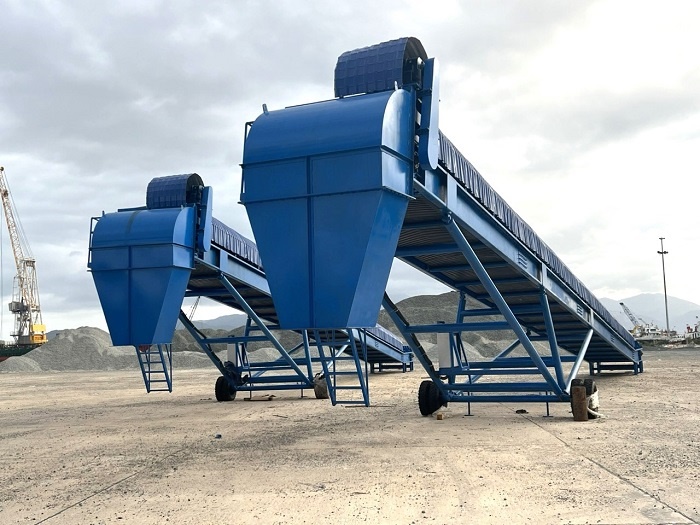
Cài đặt di động
Thuận lợi:
- Giá thành rẻ.
- Lắp đặt nhanh chóng.
- Tính cơ động & linh hoạt cao.
- Dễ dàng sửa chữa & bảo dưỡng.
- Thuyền, tàu và sà lan được neo đậu tại nhiều vị trí khác nhau.
- Không cần phải xin giấy phép kinh doanh đường thủy.
Đặc điểm chính của băng tải cầu cảng
Hiện nay, có 02 loại băng tải cầu cảng chính là băng tải di động và băng tải cố định. Băng tải di động có khả năng di chuyển đến từng vị trí cần bốc xếp nhờ hệ thống cân bằng động và bánh xe linh hoạt.
- Hệ thống băng tải thường bao gồm: 01 băng tải nâng lên và 01 băng tải hạ xuống đúng vào vị trí bốc xếp. Băng tải được nối với những dây băng tải được làm từ chất liệu vải bố, có khía chữ V rất chắc chắn với khả năng chống trượt cao đảm bảo hàng hóa được bốc xếp bám dính tốt hơn trên băng tải. Băng tải công nghiệp có thể kết nối với băng tải nâng hạ và băng tải di động.
- Vận tốc của băng tải sẽ được điều chỉnh linh hoạt nhằm phù hợp với từng loại hàng hóa cần bốc xếp cũng như đảm bảo tối ưu thời gian, công suất bốc xếp.
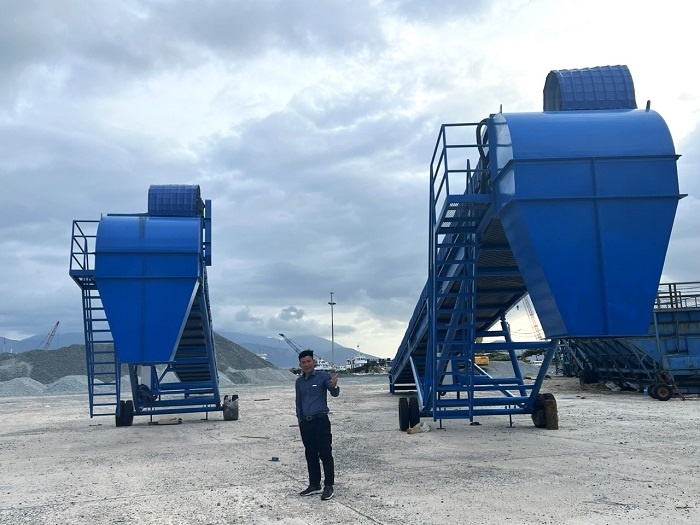
Một số tính năng vượt trội của băng tải cầu cảng
Băng tải cầu cảng được ứng dụng nhiều trong quy trình vận chuyển hàng hóa nhờ sở hữu một số ưu điểm dưới đây:
- Băng tải cầu cảng có chất lượng cao với độ bền tối ưu.
- Có khả năng vận chuyển tốt, cấu tạo băng tải tương đối đơn giản nên thuận tiện cho công tác bảo trì.
- Chi phí vận chuyển thấp, bền vững và linh hoạt.
- Có khả năng vận chuyển các sản phẩm xa bờ với khoảng cách lớn và truyền tải thông suốt.
- Có thể đầu tư nguyên vật liệu dày để tăng độ bền.
- Cự ly vận chuyển dài, khả năng vận chuyển liên tục, khối lượng lớn, công suất lớn.
- Ứng dụng rộng rãi và hữu ích trong nhiều lĩnh vực, thiết bị hỗ trợ bền bỉ và mạnh mẽ.
Ứng dụng của băng tải cầu cảng trong thực tế
Hiện nay, băng tải cầu cảng được ứng dụng trong nhiều lĩnh vực, đặc biệt là ngành công nghiệp. Băng tải cầu cảng hỗ trợ vận chuyển hàng hóa từ bờ sông đến các xe tải, xe container hoặc bốc xếp hàng hóa từ trên bờ xuống tàu, ghe dưới sông. Với khả năng chịu tải lực lớn và có thể vận chuyển trong khoảng cách xa nên các băng tải cầu cảng có thể sử dụng để vận chuyển hàng hóa có khối lượng lớn như vật liệu xây dựng, quặng, than đá,… Ngoài ra, thiết bị này còn được dùng để vận chuyển các sản phẩm hàng hóa có trọng lượng nhỏ hơn như hàng thực phẩm, nông sản, quần áo,….
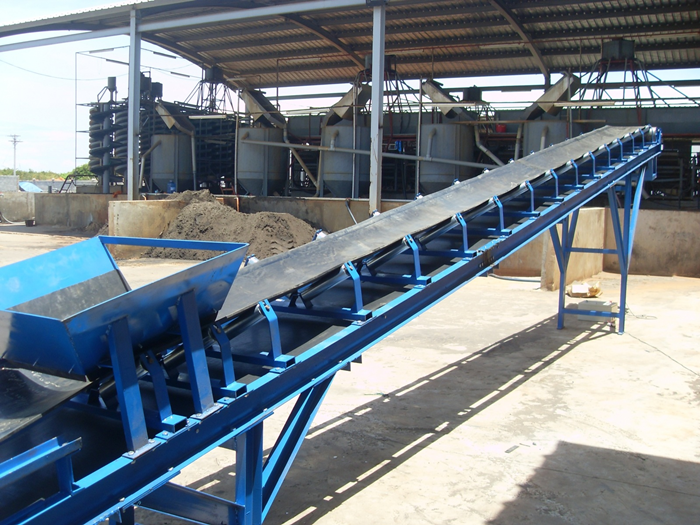
Qua bài viết, Gầu Ngoạm Sơn Tùng muốn chia sẻ đến quý bạn đọc thông tin về băng tải cầu cảng và phân tích cấu tạo cũng như đặc tính nổi bật của loại thiết bị này. Nếu quý bạn đọc có nhu cầu tìm hiểu chi tiết, vui lòng gửi lại lời nhắn hoặc liên hệ trực tiếp theo các kênh thông tin dưới đây để được hỗ trợ tận tình.
- Trụ sở: 1108 Huỳnh Tấn Phát, KP. 4, P. Tân Phú, Quận 7, TP. HCM
- Hotline: (028). 3 77 33 0 99 – 0913 602 660 - Fax: (028). 3 77 33 0 98
- Email: st@cokhisontung.com.vn
- Website: gaungoam.vn







